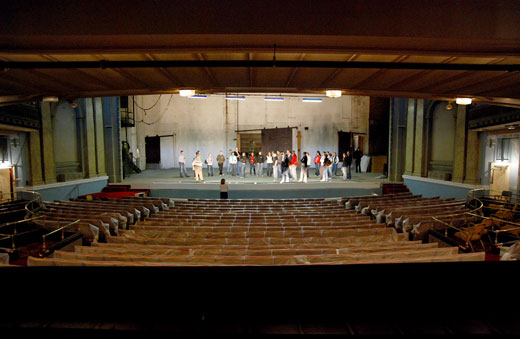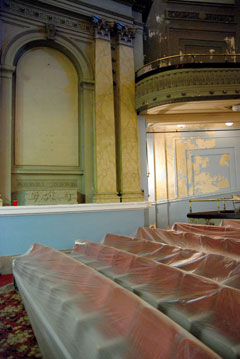Soap Dish
Cincinnati’s moth balled, but not forgotten, Emery Theater at Central Parkway and Walnut is showing signs of life and a potential comeback thanks to the efforts of community super-heroes and events like CityBeat’s Cincinnati Entertainment Awards on November 23.

 A few weeks back, your humble Soapdish observed that the Aronoff Center’s Fifth Third Bank Theater could be considered one of downtown’s most under-utilized performance spaces, save for the mothballed Emery Theater at Central Parkway and Walnut. Well, cue the klieg lights, unfurl the moth-eaten red carpet and fire up the orchestra, as the 97 year old Emery is shaking off nine years of dust and being primed for a resurrection, kicking off with next month’s Cincinnati Entertainment Awards on November 23.
A few weeks back, your humble Soapdish observed that the Aronoff Center’s Fifth Third Bank Theater could be considered one of downtown’s most under-utilized performance spaces, save for the mothballed Emery Theater at Central Parkway and Walnut. Well, cue the klieg lights, unfurl the moth-eaten red carpet and fire up the orchestra, as the 97 year old Emery is shaking off nine years of dust and being primed for a resurrection, kicking off with next month’s Cincinnati Entertainment Awards on November 23.
 For the uninitiated or unfamiliar, an abridged bit of history follows. The 2,211 seat (when originally opened) Emery, currently owned by the University of Cincinnati and under a 75 year lease to the non-profit Emery Center Corporation, occupies much of the Walnut Street side of the Emery Center Apartment building, originally the home of the Ohio Mechanics Institute, later known as the Ohio College of Applied Science. The Emery Theater was built in the style of the theater style concert halls constructed in the late 19th and early 20th centuries, including Carnegie Hall, and the Orchestra Halls in Chicago and Detroit. These halls were specifically built for the symphonies of their respective cities. The somewhat itinerant Cincinnati Symphony Orchestra, along with its then relatively-unknown twenty-seven year old conductor Leopold Stokowski, vacated their Music Hall digs in order to set up shop in the acoustically superior Emery for a 24 year run, only to return again to Music Hall in 1936. The Emery’s stage has played host to famed Russian ballet dancer Nijinsky, Bette Davis and composer George Gershwin, who performed “Rhapsody in Blue” with the Cincinnati Symphony Orchestra shortly after he had premiered it at Carnegie Hall in New York. By all accounts, Leopold’s among them, the pristine acoustics of the Emery were considered to be among the finest in the country.
For the uninitiated or unfamiliar, an abridged bit of history follows. The 2,211 seat (when originally opened) Emery, currently owned by the University of Cincinnati and under a 75 year lease to the non-profit Emery Center Corporation, occupies much of the Walnut Street side of the Emery Center Apartment building, originally the home of the Ohio Mechanics Institute, later known as the Ohio College of Applied Science. The Emery Theater was built in the style of the theater style concert halls constructed in the late 19th and early 20th centuries, including Carnegie Hall, and the Orchestra Halls in Chicago and Detroit. These halls were specifically built for the symphonies of their respective cities. The somewhat itinerant Cincinnati Symphony Orchestra, along with its then relatively-unknown twenty-seven year old conductor Leopold Stokowski, vacated their Music Hall digs in order to set up shop in the acoustically superior Emery for a 24 year run, only to return again to Music Hall in 1936. The Emery’s stage has played host to famed Russian ballet dancer Nijinsky, Bette Davis and composer George Gershwin, who performed “Rhapsody in Blue” with the Cincinnati Symphony Orchestra shortly after he had premiered it at Carnegie Hall in New York. By all accounts, Leopold’s among them, the pristine acoustics of the Emery were considered to be among the finest in the country.
Restoring the Emery to prominence (to use a tired but apt cliché) is both a worthy cause and a welcome addition to the Cincinnati theater landscape. In comparison to other cities, downtown Cincinnati is somewhat lacking in the breadth of its historic performance venues. For example, Detroit has five restored and different-sized functioning theaters, each one more lavish and opulent then the next, and all within about a mile or so of each other. Downtown Cleveland possesses a similar attraction with its Playhouse Square district downtown. While the cavernous Music Hall (technically in Over-the-Rhine, as opposed to downtown) is indeed a grand space, its origins were somewhat different, originally being constructed in 1878 for the May Festival, as well as conventions and expositions. The neighboring Memorial Hall, a 1908 era 600+ seat Beaux Art classic, sees use for chamber orchestra performances and the miscellaneous event such as last April’s hipster-fueled MusicNow festival. As far as the central business district is concerned, however, Cincinnati leveled downtown’s historic Albee Theater back in 1977 (where the Westin is now), and, in a rather hollow and pyrrhic nod to preservation, ignominiously embedded the Albee facade’s arch into the antiseptic Sixth Street entrance of the Convention Center.
 That leaves us with the somewhat utilitarian Taft, and little else. Of course, the reason that many of Detroit’s and, to a lesser extent, Cleveland’s, grand venues survived over the years was because there was so little demand for the land, even in the central business district, that they simply sat there in a mummified and entombed state (save, of course, for one unlucky space, Detroit’s 4,038 seat Michigan Theater, which was gutted for a parking garage in the 1980s, with its tattered curtains, decaying plaster medallions and crumbling proscenium still in place to this day).
That leaves us with the somewhat utilitarian Taft, and little else. Of course, the reason that many of Detroit’s and, to a lesser extent, Cleveland’s, grand venues survived over the years was because there was so little demand for the land, even in the central business district, that they simply sat there in a mummified and entombed state (save, of course, for one unlucky space, Detroit’s 4,038 seat Michigan Theater, which was gutted for a parking garage in the 1980s, with its tattered curtains, decaying plaster medallions and crumbling proscenium still in place to this day).
Getting back to the Emery, as recently as this past July, one hundred or so eager volunteers from Give Back Cincinnati and the Mayor’s Kitchen Cabinet bustled through the Emery, cleaning the place up and slathering about a fresh coat of paint. This past Saturday, after obtaining a morning elixir at the adjacent Coffee Emporium, I strolled around the corner to peer into the Emery windows. Finding the door ajar, I walked in to find Dale McGirr, Senior Planner with GBBN Architects, and formerly Senior Vice President Emeritus of Special Projects at the University of Cincinnati. McGirr was preparing for  yet another Give Back tour that afternoon, and agreed to give me a preview. The Emery is currently in possession of only a temporary certificate of occupancy, so the type of functions it can accommodate are quite limited in scope. Moreover, it is clear that there is a lot of work to be done, both aesthetically as well as basic infrastructure, in order to get the space fully functioning and in code-compliant condition. One decided advantage, however, is that the Emery has remained relatively secure and, most critically, dry during its dormant stages, thereby avoiding the bete noir of theater preservationists—water damage. Nevertheless, current backers can use this time to identify, assess and prioritize their needs, generate the flashy publicity (ahem) and then embark on the necessary fundraising to get them where they need to be. Beth Sullebarger of the Emery Center Corporation has previously gone on record as envisioning a three-phased, $20 million dollar restoration that would restore the orchestra level seating by 2009 and restore the first and second balconies in time for the building’s 100th anniversary.
yet another Give Back tour that afternoon, and agreed to give me a preview. The Emery is currently in possession of only a temporary certificate of occupancy, so the type of functions it can accommodate are quite limited in scope. Moreover, it is clear that there is a lot of work to be done, both aesthetically as well as basic infrastructure, in order to get the space fully functioning and in code-compliant condition. One decided advantage, however, is that the Emery has remained relatively secure and, most critically, dry during its dormant stages, thereby avoiding the bete noir of theater preservationists—water damage. Nevertheless, current backers can use this time to identify, assess and prioritize their needs, generate the flashy publicity (ahem) and then embark on the necessary fundraising to get them where they need to be. Beth Sullebarger of the Emery Center Corporation has previously gone on record as envisioning a three-phased, $20 million dollar restoration that would restore the orchestra level seating by 2009 and restore the first and second balconies in time for the building’s 100th anniversary.
As currently contemplated, the Emery, utilizing its first two massive balconies, would reconfigure as an approximately 1,200 seat venue, thereby positioning it competitively for mid-sized touring shows and bands that currently pass over Cincinnati for cities such as Columbus, Indianapolis and Louisville. In addition, a look inside the theater’s soaring interior reveals yet a third balcony, far up in the nosebleed seats. Interestingly enough, however, the third balcony is apparently structurally isolated, perhaps more appropriately described as segregated, from the rest of the theater, with separate access doors, stairwells and ticket windows. While the planners contemplate how to integrate the third balcony with the balance of the theater, they remain confident that a reconfigured capacity of 1,200, without the additional balcony, should position the venue nicely for future events.
 Indeed, while discussing these finer points with McGirr, local arts booster and consultant Joan Kaup strolled in to the theater. Kaup is assisting in efforts to bring to Cincinnati the 2012 World Choir Games, and a renovated Emery Theater is key to those efforts. These games bring in over 400 amateur choir ensembles from over 90 countries, with the 2008 games being held in Graz, Austria and the 2010 games slated for Shaoxing, China. According to Kaup, Cincinnati, along with, um…Reno, Nevada, is one of two finalists for the 2012 games (they have never been held in the U.S.), and the site selection Committee will be in town next week to inspect the venues, including the Emery. Organizers envision a walkable axis of venues for the event, consisting of Music and Memorial Halls to the west, the new SCPA and the (hopefully fully) restored Emery Theater.
Indeed, while discussing these finer points with McGirr, local arts booster and consultant Joan Kaup strolled in to the theater. Kaup is assisting in efforts to bring to Cincinnati the 2012 World Choir Games, and a renovated Emery Theater is key to those efforts. These games bring in over 400 amateur choir ensembles from over 90 countries, with the 2008 games being held in Graz, Austria and the 2010 games slated for Shaoxing, China. According to Kaup, Cincinnati, along with, um…Reno, Nevada, is one of two finalists for the 2012 games (they have never been held in the U.S.), and the site selection Committee will be in town next week to inspect the venues, including the Emery. Organizers envision a walkable axis of venues for the event, consisting of Music and Memorial Halls to the west, the new SCPA and the (hopefully fully) restored Emery Theater.
With the centennial of the Emery only a few years away, it is evident that the organizers have a fairly serendipitous, albeit ambitious, timetable for the project. While the theater has endured several aborted restoration attempts in the 1980’s and 1990’s, the project has continued to meander along in relative anonymity until these most recent stirrings. Keep your eyes peeled for more functions, fundraisers and events for and at the Emery Theater in the future. As unofficial Cincinnati Arts Booster Emeritus, scooter aficionado, Emery supporter and erstwhile concert promoter Jim Tarbell is fond of saying, “just imagine a Prairie Home Companion performing live on that stage, or a Bob Dylan concert…” Sounds good to me. Perhaps Tarbell is itching to get back into the concert promotion business and start booking the Emery. In the meantime, I’ll see everyone at the CEA Awards at the Emery on November 23.
Photography by Scott Beseler at the Emery Theater













